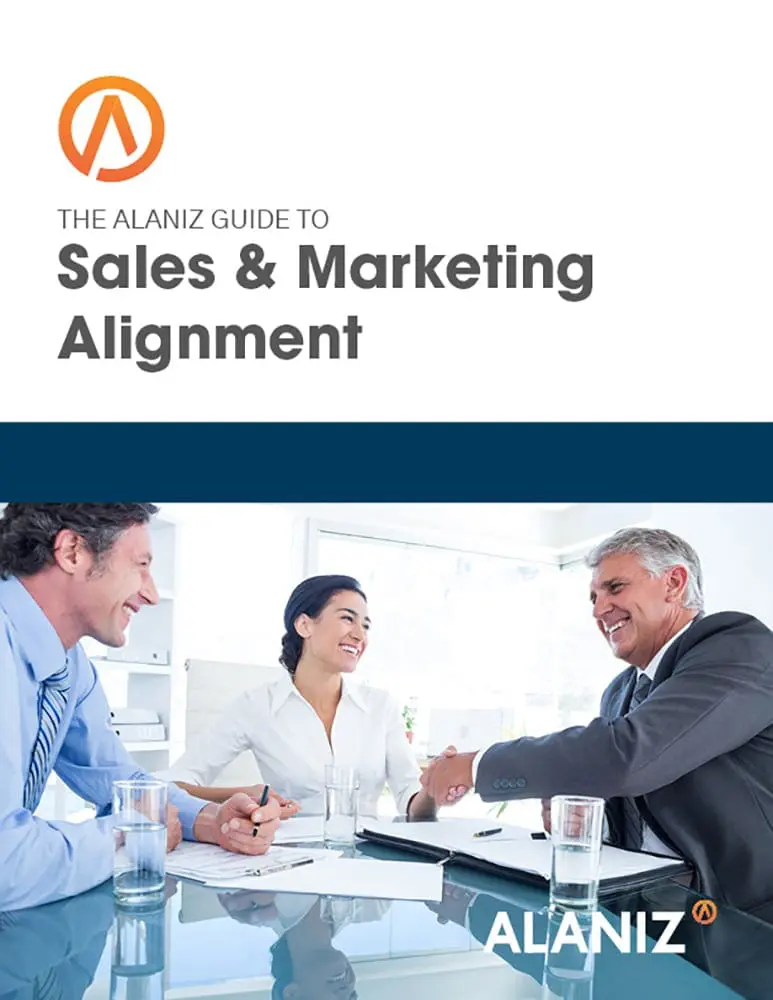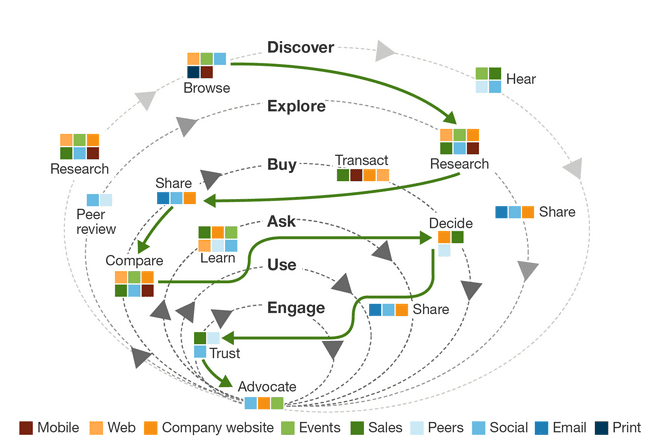 The key to attracting visitors and converting them into leads depends on two factors: a buyer persona and the buyer’s journey. In this blog post, we’ll explore how to best optimize your content for a particular location along the buyer’s journey (to learn about buyer personas, click here).
The key to attracting visitors and converting them into leads depends on two factors: a buyer persona and the buyer’s journey. In this blog post, we’ll explore how to best optimize your content for a particular location along the buyer’s journey (to learn about buyer personas, click here).
Each and every blog post you publish should be written with a specific part of the buyer’s journey in mind.
Of course, that’s easier said than done. It’s not easy to figure out what questions your potential customers have, when they’re asking them, and how to answer them.
On the other end of the spectrum, potential buyers face the challenge of determining what online content is just noise and what is actually valuable to solving their specific problems. If you want to provide that value (and ultimately attract more qualified leads), you can start by targeting a specific part of the buyer’s journey for each blog post.
What is the buyer’s journey?
The buyer’s journey consists of three stages: awareness, consideration, and decision. This “journey” is the active research process a potential buyer goes through leading up to a purchase. With the proven concept of inbound marketing, it allows us marketers to conceptualize the buyer’s journey as a framework to create targeted content for each stage.
To plan and write blog posts for each of these stages and each part of the methodology you need to know:
- Who these leads are (that’s where buyer personas come into play)
- What questions your leads are asking
- Where they’re looking for answers to their questions
- How to answer those questions
- When you should answer them
Once you understand the buyer’s journey, it’s time to plan blog posts for each part.
Awareness stage
In the awareness stage, a potential buyer is just realizing a want or need for a product and/or service. 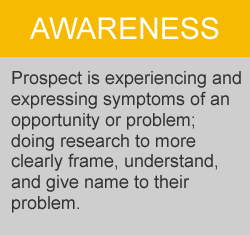 They are aware of a problem they have, but don’t know the solution. They are entering search terms in Google to clearly understand more about what they are looking for. This is where an effective SEO strategy play a major role in online marketing — so your company shows up in relevant search results.
They are aware of a problem they have, but don’t know the solution. They are entering search terms in Google to clearly understand more about what they are looking for. This is where an effective SEO strategy play a major role in online marketing — so your company shows up in relevant search results.
Most potential buyers in this awareness stage are seeking neutral information to answer questions or resolve pain points they may have. They are asking, “Why do I have this problem?” and “How can I fix this problem?” Additionally, they are exploring “How do other people/companies handle this problem?” and “What will happen if I don’t get this problem resolved?”
Your potential buyers are asking questions based around the long-tail keywords that they’re searching.
To be an effective marketer, it is important to recognize this type of buyer mentality and cater your marketing communications to provide solutions, ideas, and purpose to what it is they’re interested in.
If they ask those kinds of questions, what search terms would they be using? Relevant terms probably include words like troubleshoot, how to, upgrade, improve, optimize, and prevent. Marketers know that Google gives you lists of long-tail keywords that are actually being searched. Use these as a starting point for your SEO in your awareness stage offers and blog posts to help attract more leads.
Awareness stage content
What types of content and what content formats fit for the awareness stage? A few content offer formats to consider are:
- eGuides and eBooks
- White papers
- Checklists
- Infographics
- Industry research/analyst reports
This should all be educational content, based around the questions your potential buyers are asking. (Hint: they’re not asking questions about your products and services, they are asking questions based around the long-tail keywords they’re using.)
6 awareness stage blog topics
The blog posts that belong in this stage should educate readers about the problem: why it might be happening and potential solutions. Again, this is a high level — in fact, you want to mention your company’s product or service very little, if at all. In this stage, the reader doesn’t know what solution they’re seeking, so they’re certainly not ready to buy.
Blog topics should relate to your buyer personas and their pains. Here are a few ideas to get you started:
- “How to Solve the Biggest Problems with ___________”
- “The Ultimate Cheat Sheet of _________________”
- “20 Myths About ___________________”
- “The Worst Advice We’ve Ever heard About _________________________”
- “7 Things About ______ Your Boss Wants to Know”
- “10 Quick Tips About _____________”
The content in these blogs provide information that further educates readers without being explicitly related to your company.
Why bother with awareness stage posts that won’t result in immediate sales? First, awareness level posts typically target broad search terms, which casts a wide net for attracting a lot of visitors. Plus, discovery is just the first step, and there’s a long way to go before the person is ready to buy.
However, just by reading a high-level blog post, they’ve learned more about your company and gained a little trust. When they move into the consideration stage (one step closer to buying), they’ll likely think of you again.
Consideration stage
The buyer now has a defined problem they’re trying to remedy. At this point, they likely know either what’s causing their problem and/or their options to fix it.
The desire to compare products indicates this customer is further along in the buyer’s journey, however, it does not necessarily mean they want to be sold to… yet. You are still delivering information that makes your buyer more intelligent about their potential purchase.
Consideration stage content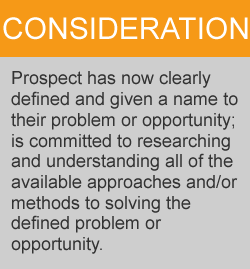
Here are some examples of content offers you should provide to qualify your lead for the decision stage:
- Product comparison guides
- Expert guides
- Webinars or podcasts
- Video
- Templates
- Calculators
- Case studies
For many B2B companies, the consideration stage is also a kind of “brand filter,” where you should introduce information about your products and services. Hence the product comparison guide above, or a case study showing your amazing results.
5 consideration stage blog topics
In all of these blog posts, you could offer quick, easy solutions that may or may not use your company’s offerings. Posts like these further build trust with readers — people like to see companies that don’t only promote their own products. By sharing other options, it’s clear to the reader that you actually want to help them find a solution.
Another great benefit of consideration level posts is that the search terms used to find them are often more specific, but not too specific to rank for. This means that your visitors will be more qualified.
Some blog posts here might include:
- “Why Digital Marketing Alone Doesn’t Lead to a Strong ROI”
- “5 Ways to Fix a Broken Compressor in Your Refrigeration System”
- “How to Select an Executive Education Program”
- “The Top 10 Apps to Track Time”
- “The Measurable Value of a Workplace Wellness Program”
Each of these topics start to position you as an expert in these respective fields.
Finally, it’s at the consideration level that prospects are likely to convert to leads. They’re hungry for information, so if you can provide more useful content, you’ll likely be able to add them to your contact list and help them make a decision.
Decision stage
Alright, now it’s time to sell! Now that a potential buyer is evaluating their purchase decision as a qualified lead, it is imperative for your team to create content with one goal in mind, and that is to move the prospect even closer to purchase.
Decision stage content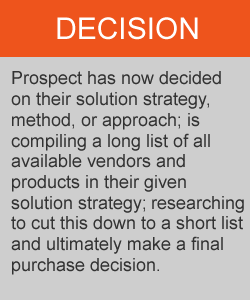
While the majority of decision-stage content typically comes in the form of gated or premium content or via email, blog posts can help, too. In these blogs, you’ll talk about your company, service or product specifically.
During this stage, it is recommended to include the following in your marketing strategy:
- Leverage customer testimonials or case studies
- Offer a free trial download or live demo
- Provide spec sheets and/or product literature
- Tell your brand’s story
- Utilize PPC ad text featuring a limited time discount
Close the deal by including keywords such as compare, pros and cons, benchmarks, review, or test.
4 decision stage blog topics
Even though decisions stage blog posts are about you, the key is to make them about the buyer. That is, the post shouldn’t say “We’re the best option because…” it should say “You’ll solve your problem and be better off with our help.”
The blog posts might look like this:
- “How [Your Company] Solves [Their Pain]”
- “3 Reasons Why [Your Company] is the Best ___________”
- “DEMO: How to Use _________ to [Solve Pain]”
- “How [Past Client] Went From _______ to ________ in 10 Weeks”
While there’s limited search potential for posts like these, the benefit often comes in the form of nurture marketing. Because your blog post lives on forever, you can continually reference it in premium content or nurture emails.
How it all breaks down
All blog posts should fall into one specific part of the buyer’s journey to help move prospective customers further down the funnel. HubSpot suggests this breakdown to can help you plan:
- At least 70% of all posts written as a reference in the awareness stage.
- Consideration posts should make up about 20% of your total blog posts.
- The decision stage should hold 10% of your blogs.
When planning your blog posts, keep the journey and the inbound methodology in mind. Assign each blog post one of the three stages. It’s important to do this strategizing before you start writing so that you know what questions to answer. In fact, you might want to jot down or pin up these questions, so you always remember what each buyer might be seeking:
Awareness Stage – “What problem do I have?”
Consideration Stage – “What are the options to solve my problem?”
Decision Stage – “Is this the best option?”
That is the buyer’s journey in a nutshell. With proper inbound marketing tactics applied to each of these three stages, you’ll be able to make content available through the right channels. Remember the main goal of buyer’s journey, take advantage of a more customer-centric philosophy to better position your company for addressing the needs of your target audience, converting them into leads and ultimately, into customers.
Buyer’s journey image courtesy of Lori Wizdo at Forrester![]()
